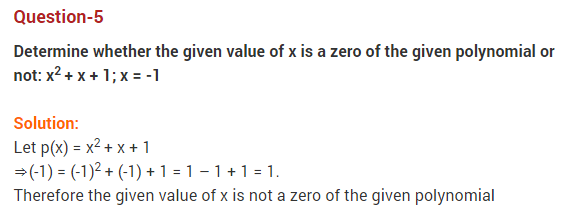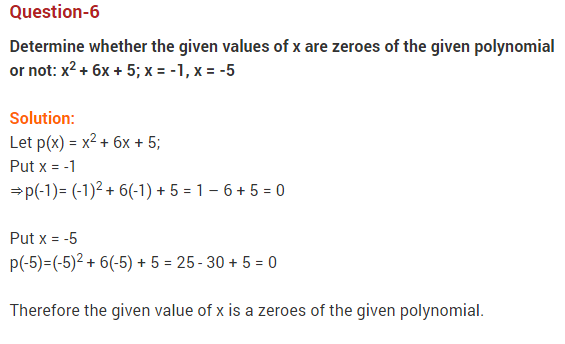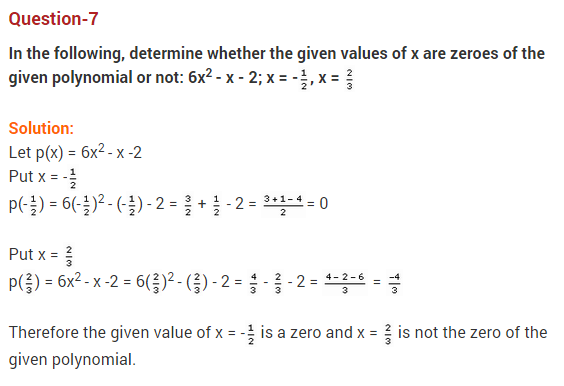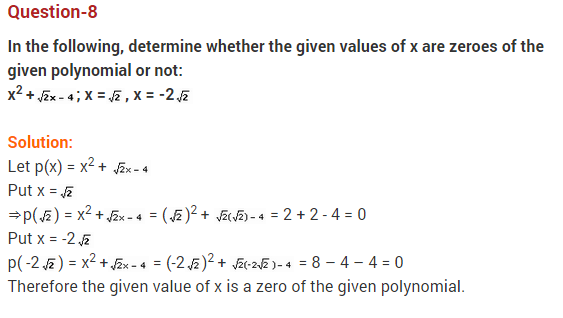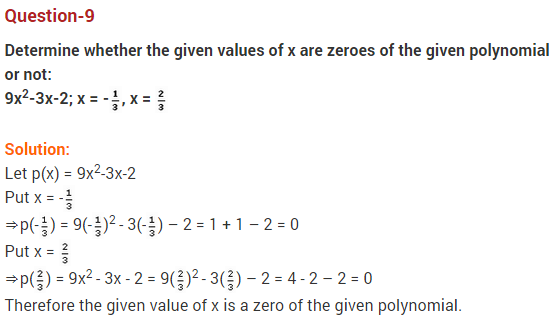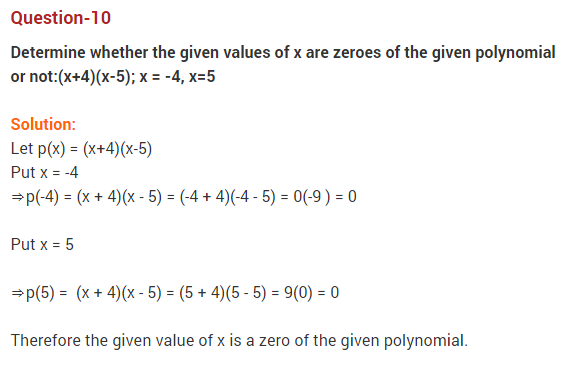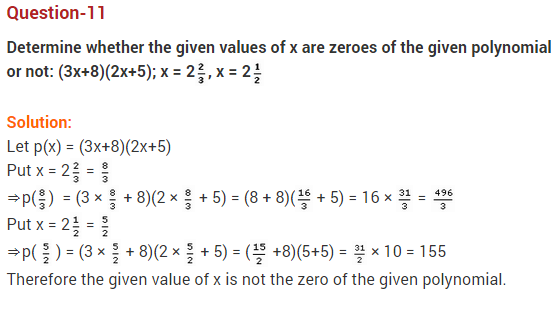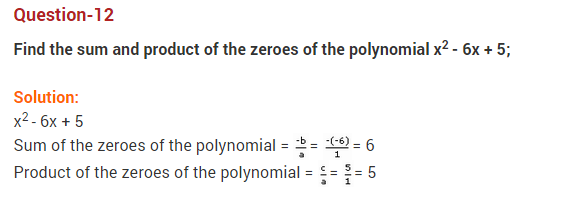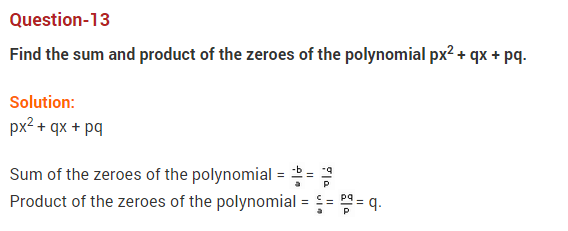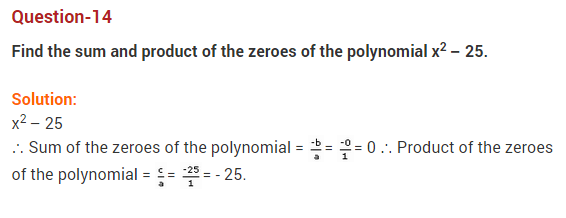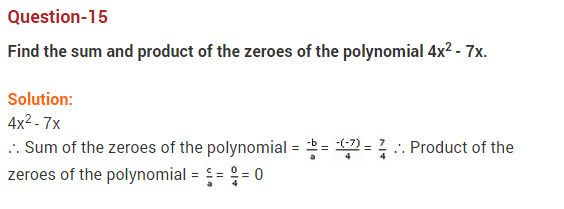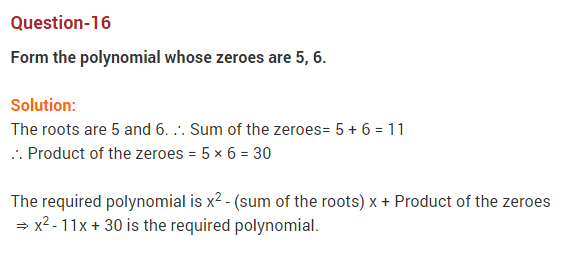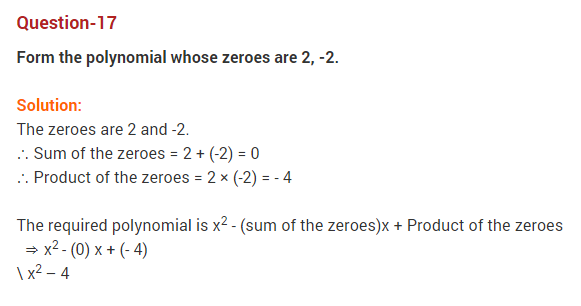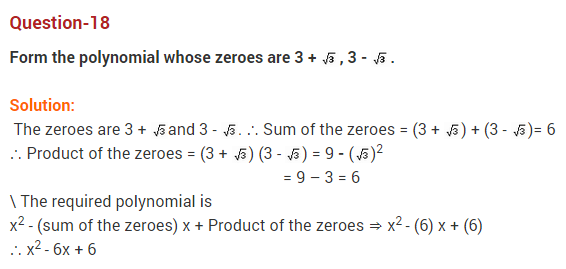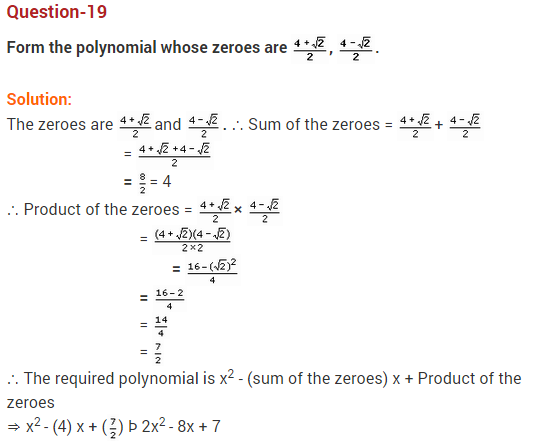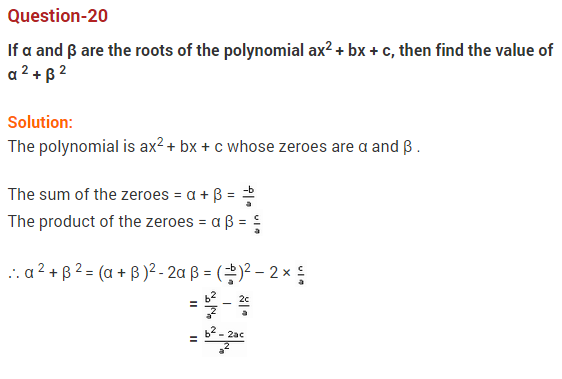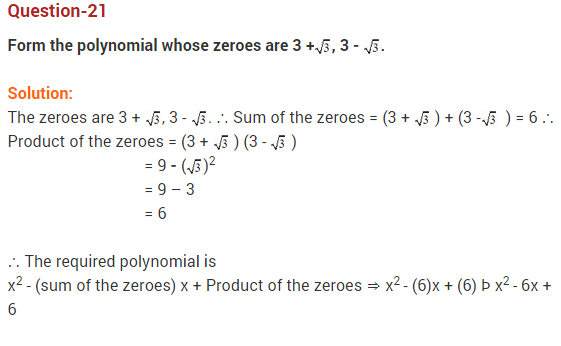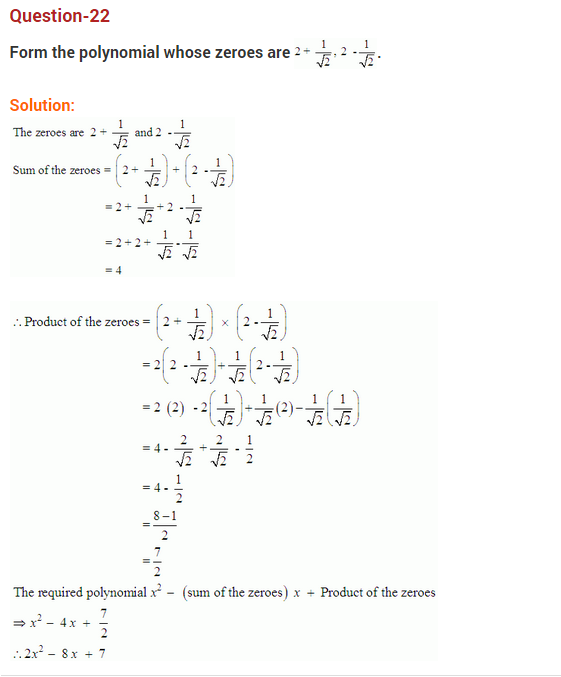Polynomials Class 10 Extra Questions Maths Chapter 2 with Answers
Extra Questions for Class 10 Maths Chapter 2 Polynomials. According to new CBSE Exam Pattern, MCQ Questions for Class 10 Maths Carries 20 Marks.
Polynomials Class 10 Extra Questions Very Short Answer Type
Question 1.
The graph of a quadratic polynomial x2 – 3x – 4 is a parabola. Determine the opening of parabola.
Answer:
∵ In x2 – 3x – 4, the Coefficient of x2 is 1 and 1 > 0.
∴ The parabola opens upwards.
Question 2.
If p(x) = x2 + 5x + 2, then find p(3) + p(2) + p(0).
Answer:
p(3) = 32 + 5(3)+ 2 = 26
p(2) = 22 + 5(2) + 2 = 16
p(0) = 02 + 5(0) + 2 = 2
⇒ p(3) + p(2) + p(0) = 26 + 16 + 2 = 44
Question 3.
The graph of y = p(x) is shown in the figure below. How many zeroes does p(x) have?
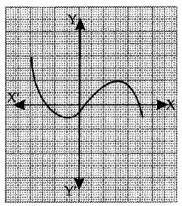
Answer:
Since, the curve (graph) of p(x) is intersecting the x-axis at three points, y = p(x) has 3 zeroes.
Question 4.
The coefficient of x and the constant term in a linear polynomial are 5 and – 3 respectively, find its zero.
Answer:
∵ The zero of a linear polynomial = – \(\frac{\text { Constant term }}{\text { Coefficient of } x}\)
∴ The zero of the given linear polynomial
= – \(\frac{(-3)}{5}=\frac{3}{5}\)
Question 5.
What is the value of p(x) = x2 – 3x – 4 at x = -1 ?
Answer:
We have: p(x) = x2 – 3x – 4
∴ P(- 1) = (- 1)2 – {3(- 1)} – 4 = 1 + 3 – 4
= 0
Question 6.
If the polynomial p(x) is divisible by (x – 4) and 2 is a zero of p(x), then write the corresponding polynomial.
Answer:
Here, p(x) is divisible by (x – 4) and also 2 is a zero of p(x), therefore p(x) is divisible by (x – 4) and (x – 2)
Thus, the required polynomial p(x) = (x – 4) (x – 2) = x2 – 6x + 8.
Question 7.
If (α – β), α, (α + β) are zeroes of the polynomial p(x) = 2x3 – 16x2 + 15x – 2, then find the value of α
Answer:
Sum of zeroes = – \(\frac{\text { Coeff. of } x^2}{\text { Coeff. of } x^3}\)
⇒ (α – β), α, (α + β) = \(\frac{-(-16)}{2}\)
⇒ 3α = 8
⇒ α = \(\frac{8}{3}\)
Question 8.
What is the zero of 2x + 3?
Answer:
∵ The zero of a linear polynomial = – \(\frac{\text { Constant term }}{\text { Coefficient of } x}\)
∴ The zero of 2x + 3 = – \(\frac{3}{2}\)
Question 9.
Find the value of p for which the poloynomial x3 + 4×2 – px + 8 is exactly divisible by (x – 2).
Here p(x) = x3 + 4x2 – px + 8
∵ (x – 2) divides p(x), exactly
⇒ P(2) = 0
⇒ (2)3 + 4 (2)2 – p(2) + 8 = 0
2p = 32 ⇒ p = 16
Question 10.
If α and β are zereos of the polynomial 2x2 – 5x + 7, then find the value of α-1 + β-1.
Answer:
Here p(x) = 2x2 – 5x + 7
α, β are zeroes of p(x)

Question 11.
If p and q are the roots of ax2 – bx + c = 0, a ≠ 0, then find the value of p + q.
Answer:
Here, p and q are the roots of ax2 – bx + c = 0.
Sum of roots = \(\frac{-b}{a}\)
∴ p + q = \(\frac{-b}{a}\)
Question 12.
If – 1 is a zero of quadratic polynomial, p(x) = kx2 – 5x – 4, then find the value of k.
Answer:
Here p(x) = kx2 – 5x – 4
Since – 1 is a zero of p(x)
∴ P(- 1) = o
⇒ k (-1)2 – 5(- 1) – 4 = 0
⇒ k + 5 – 4 = 0
⇒ k = – 1
Polynomials Class 10 Extra Questions Short Answer Type-1
Question 1.
Find the quadratic polynomial whose sum of zeroes is 8 and their product is 12. Hence find zeroes of polynomial.
Answer:
Let, α, β be zereos of polynomial.
Now, here α + β = 8, αβ = 12.
Required polynomial
p(x) = k{x2 – (α + β) x + α β),
k is a constant.
⇒ p(x) = k{x2 – 8x + 12}
In particular, taking k = 1
Reqd. polynomial = x2 – 8x + 12
Now, p(x) = x2 – 8x + 12
= x2 – 6x – 2x + 12
= x(x – 6) – 2(x – 6)
= (x – 6) (x – 2)
∴ p(x) = o
⇒ x = 6, 2
Thus zeroes of polynomial are 6 and 2.
Question 2.
Check whether x2 + 3x + 1 is a factor of 3x4 + 5x3 – 7x2 + 2x + 2.
Answer:
Let p(x) = 3x4 + 5x3 – 7x2 + 2x + 2,
g(x) = x2 + 3x + 1
Next we divide p(x) by g(x).
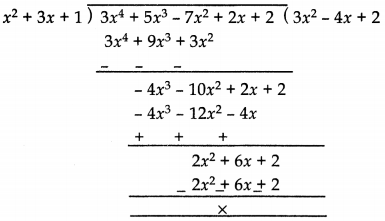
Using division algorithm
3x4 + 5x3 – 7x2 + 2x + 2 = (x2 + 3x + 1) (3x2 – 4x + 2) + 0
= (x2 + 3x + 1) (3x2 – 4x + 2)
Clearly, as remainder is 0, so the divisor x2 + 3x + 1 appear on R.H.S as factor of 3x4 + 5x3 7x2 + 2x + 2.
Question 3.
If one zero of the polynomial (a2 + 9)x2 + 13x + 6a is reciprocal of the other, find the value of a.
Answer:
Let α, \(\frac{1}{\alpha}\) be the zeroes of (a2 + 9)x2 + 13x + 6a
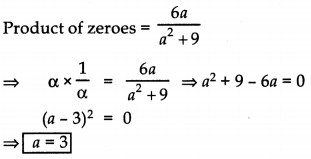
Question 4.
If α and β are zeroes of x2 + 7x + 12, then find the value of \(\frac{1}{\alpha}+\frac{1}{\beta}\) – 2αβ
Answer:
Here α + β = – 7, αβ = 12
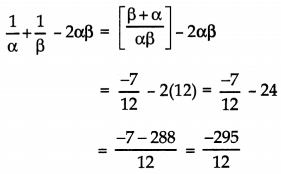
Question 5.
Find α-1 + β-1, if α and β are zereos of the polynomial 9x2 – 3x – 2.
Answer:
Since α and β are zereos of p(x) = 9x2 – 3x – 2

Question 6.
Find whether 2x3 – 1 is a factor of 2x5 + 10x4 + 2x2 + 5x + 1 or not.
Answer:
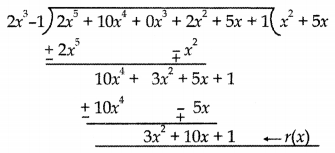
Since r(x) ≠ 0
∴ 2x3 – 1 is not a factor of given polynomial.
Question 7.
If α, β, γ are zeroes of the polynomial f(x) = x3 – 3x2 + 7x – 12, then find the value of (αβ)-1 + (βγ)-1 + (γα)-1.
Answer:
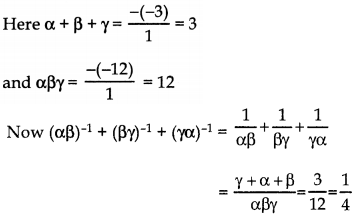
Question 8.
For what value of k is the polynomial x3 + kx2 + 3x – 18 is exactly divisible by (x – 3).
Answer:
If p(x) = x3 + kx2 + 3x – 18 is exactly divisible by (x – 3)
⇒ p(3) = 0 ⇒ (3)3 + k(3)2 + 3(3) – 18 = 0
⇒ 9k = – 18 ⇒ k = – 2
Polynomials Class 10 Extra Questions Short Answer Type-2
Question 1.
Find all the zeroes of 2x4 – 13x3 + 19x2 + 7x – 3, if you know that two of its zeroes are 2 + √3 and 2 – √3. [C.B.S.E. 2019]
Answer:
Given, x = (2 + √3) and x = (2 – √3) are zeroes of p(x) = 2x4 – 13x3 + 19x2 + 7x – 3
∴ (x – (2 + √3)) (x – (2 – √3)) is factor of p(x).
⇒ (x – 2 – √3) (x – 2 + √3) is factor of p(x).
= (x – 2)2 – (√5)2
= x2 – 4x + 4 – 3
= x2 – 4x + 1
Now, we divide p(x) by x2 – 4x + 1
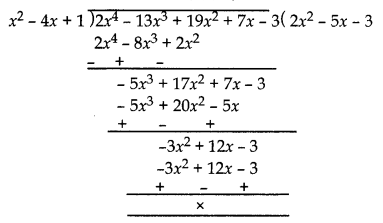
Now p(x) = (x2 – 4x + 1) (2x2 – 5x – 3)
∴ Other zeroes are given by
2x2 – 5x – 3 = 0
⇒ 2x2 – 6x + x – 3 = 0
⇒ 2x (x – 3) + 1 (x – 3) = 0
⇒ (2x + 1) (x – 3) = 0
⇒ 2x + 1 = 0 or x – 3 = 0
x = – \(\frac{1}{2}\), 3
∴ Zeroes of given polynomial are
– \(\frac{1}{2}\), 3, (2 + √3), (2 – √3)
Question 2.
Find all the zeroes of 2x4 – 3x3 – 3x2 + 6x – 2, if it is given that two of its zeroes are 1 and \(\frac{1}{2}\). [CBSE 2019 (C) Set-B]
Answer:
Given: x = 1, x = \(\frac{1}{2}\) are zeroes of p(x) = 2x4 – 3x3 – 3x2 + 6x – 2
∴ (x – 1) and (x – \(\frac{1}{2}\)) or (2x – 1) are factor of p(x).
⇒ (x – 1) (2x – 1) = 2x2 – 3x + 1 is a factor of p(x).
Next, we divide p(x) by 2x2 – 3x + 1.
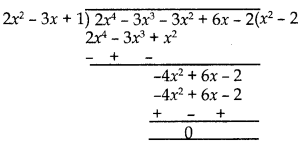
∴ p(x) = (2x2 – 3x + 1) (x2 – 2)
∴ Other zeroes are given by (x2 – 2) = 0
⇒ x = ±√2
∴ Zeroes of p(x) are – √2, \(\frac{1}{2}\), 1, √2.
Question 3.
Find all zeros of the polynomial 3x3 + 10x2 – 9x – 4, if one of its zero is 1. [CBSE 2019]
Answer:
Let p(x) = 3x3 + 10x2 – 9x – 4
Since, 1 is a zero of p(x)
Therefore, (x – 1) is a factor of p(x)
Dividing p(x) by (x – 1), we have:
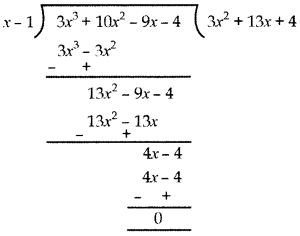
∴ By Division Algorithm,
p(x) = (3x2 + 13x + 4)(x – 1)
Zeroes of p(x) are given by p(x) = 0
⇒ (3x2 + 13x + 4)(x – 1) = 0
⇒ (3x2 + 12x + x + 4)(x – 1) = 0
⇒ {3x(x + 4) + 1 (x + 4)}(x – 1) = 0
⇒ (x + 4 )(3x + 1) (x – 1) = 0
⇒ x + 4 = 0
or 3x + 1 = 0 or x – 1 = 0
⇒ x = – 4, – \(\frac{1}{3}\), 1
∴ Zeroes of p(x) are – 4, – \(\frac{1}{3}\), 1.
Question 4.
Divide the polynomial 3x3 – 6x2 – 20x + 14 by the polynomial x2 – 5x + 6 and verify the division algorithm. [CBSE Delhi 2016]
Answer:
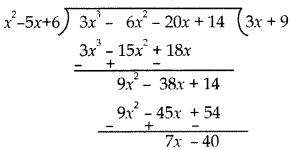
By division algorithm,
3x3 – 6x2 – 20x + 14 = (x2 – 5x + 6)(3x + 9) + (7x – 40)
or, p(x) = q(x) g(x) + r(x)
Question 5.
If α and β are the zeroes of a quadratic polynomial x2 – x – 2 then find the value of \(\left(\frac{1}{\alpha}-\frac{1}{\beta}\right)\).
Answer:
Comparing x2 – x – 2 with ax2 + bx + c, we have a = 1, b = – 1, c = -2
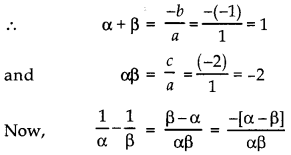
[∵ (α – β)2 = (α + β)2 – 4αβ
= (1)2 – 4 (- 2) = 1 + 8 = 9
∴ α – β = √9
⇒ (α – β) = ± 3]
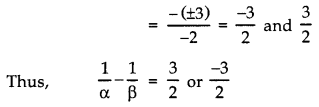
Question 6.
On dividing p(x) by a polynomial x – 1 – x2, the quotient and remainder were (x – 2) and 3 respectively. Find p(x).
Answer:
Here,
dividend = p(x)
Divisor, g(x) = (x – 1 – x2)
Quotient, q(x) = (x – 2)
Remainder, r(x) = 3
∵ Dividend = [Divisor × Quotient] + Remainder
∴ P(x) = [g(x) × q(x)] + r(x)
= [(x – 1 – x2) (x – 2)] + 3
= [x2 – x – x3 – 2x + 2 + 2x2] + 3
= 3x2 – 3x – x3 + 2 + 3
= – x3 + 3x2 – 3x + 5
Question 7.
Find the zeroes of the quadratic polynomial 5x2 – 4 – 8x and verify the relationship between the zeroes and the coefficients of the polynomial.
Answer:
p(x) = 5x2 – 4 – 8x = 5x2 – 8x – 4
= 5x2 – 10x + 2x – 4
= 5x(x – 2) + 2(x – 2)
= (x – 2) (5x + 2)
= 5(x – 2) (x + \(\frac{2}{5}\))
∴ Zeroes of p(x) are 2 and – \(\frac{2}{5}\)
Relationship Verification:
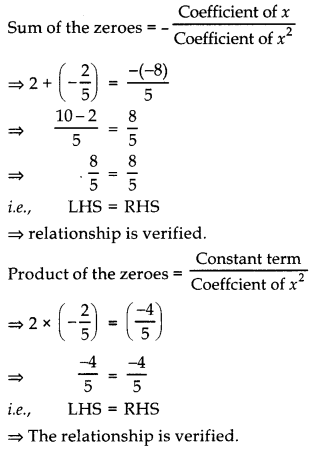
Polynomials Class 10 Extra Questions Long Answer Type 1
Question 1.
If the polynomial x4 + 2x3 + 8x2 + 12x + 18 is divided by another polynomial x2 + 5, the remainder comes out to be px + q. Find the values of p and q.
Answer:
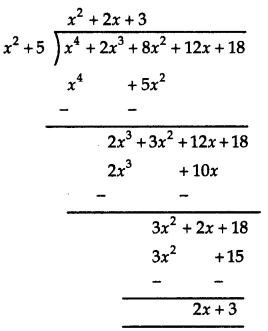
∴ Remainder = 2x + 3
Comparing 2x + 3 with px + q, we have
p = 2 and q = 3
Question 2.
If α, β, γ are the zeroes of p(x) = x3 – 7x2 + 11x – 7 find the value of
(i) α2 + β2 + γ2
(ii) α3 + β3 + γ3
Answer:
Comparing p(x) = x3 – 7x2 + 11x – 7 with standard cubic polynomial ax3 + bx2 + cx + d, we have
a = 1, b = – 7, c = 11, d = – 7

(i) Now, since (α + β + γ)2 = α2 + β2 + γ2 + 2(αβ + βγ + γα)
⇒ α2 + β2 + γ2 = (α + β + γ)2 – 2(αβ + βγ + γα)
= (7)2 – 2(11) = 49 – 22 = 27
(ii) Since
α3 + β3 + γ3 – 3αβγ = (α2 + β2 + γ2 – αβ – βγ – γα)
(α + β + γ)
= {(α + β + γ)2 – 2(αβ + βγ + γα) – (αβ + βγ + γα)}(α + β + γ)
⇒ α3 + β3 + γ3 = {(α + β + γ)2 – 3(αβ + βγ + γα)} (α + β + γ) + 3αβγ
= {72 – 3(11)} 7 + 3 × 7
= (49 – 33) 7 + 21
= 16 × 7 + 21 = 133.
Question 3.
Find the quadratic polynomial whose zeroes are 1 and – 3. Verify the relation between the coefficients and the zeroes of the polynomial.
Answer:
∵ The given zeroes are 1 and – 3.
∴ Sum of the zeroes = 1 + (- 3) = – 2
Product of the zeroes = 1 × (- 3) = – 3
A quadratic polynomial p(x) is given by
x2 – (sum of the zeroes) x + (product of the zeroes)
∴ The required polynomial is
x2 – (- 2)x + (-3)
⇒ x2 + 2x – 3
Verification of relationship
∵ Sum of the zeroes = – \(\frac{\text { [coeff. of } x]}{\text { Coeff. of } x^2}\)
∴ 1 + (- 3) = \(\frac{-[2]}{1}\)
⇒ – 2 = – 2
i.e., LHS = RHS
⇒ The sum of zeroes is verified.
∵ Product of the zeroes = \(\frac{\text { [Constant term] }}{\text { Coefficient of } x^2}\)
∴ 1 × (- 3) = \(\frac{[-3]}{1}\)
⇒ – 3 = – 3
i.e., L.H.S. = R.H.S.
⇒ The product of zeroes is verified.
Question 4.
What must be added to 6x5 + 5x4 + 11x3 – 3x2 + x + 1, so that the polynomial so obtained is exactly divisible by 3x2 – 2x + 4?
Answer:
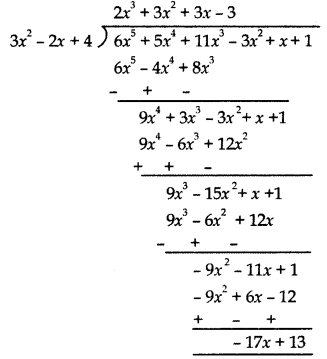
Therefore, we must add -(- 17x + 13),
i.e., 17x – 13.
Question 5.
Find the value of b for which the polynomial 2x3 + 9x2 – x – b is divisible by 2x + 3.
Answer:
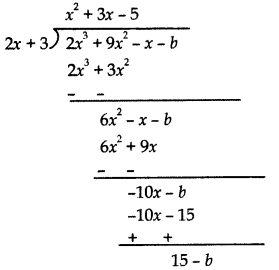
If the polynomial 2x3 + 9x2 – x – b is divisible by 2x + 3, then the remainder must be zero.
So, 15 – b = 0
⇒ b = 15
Question 6.
Find the zeroes of a cubic polynomial p(x) = 3x3 – 5x2 – 11x – 3 when it is given that product of two of its zeroes is -1.
Answer:
Here, p(x) = 3x3 – 5x2 – 11x – 3
On comparing p(x) with ax3 + bx2 + cx + d, we have;
a = 3, b = -5, c = -11, d = -3
Let α β γ be the zeroes of the given polynomial.
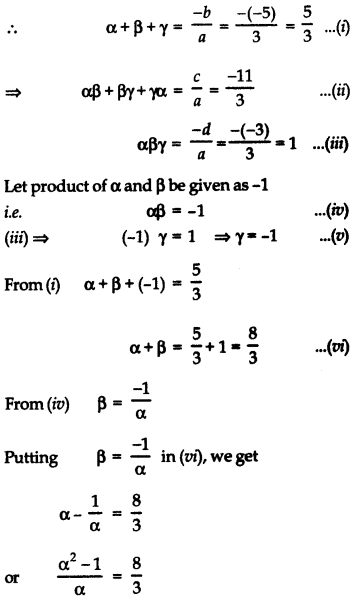
⇒ 3α2 – 3 = 8α
⇒ 3α2 – 8α – 3 = 0
⇒ 3α2 – 9α + α – 3 = 0
⇒ 3α(α – 3) + 1 (α – 3) = 0
⇒ (α – 3) (3α + 1) = 0
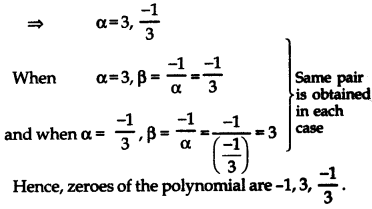
Polynomials Class 10 Extra Questions HOTS
Question 1.
If p and q are the zeroes of x2 + px + q, then find the values of p and q.
Answer:
p, q are the zeroes of x2 + px + q.
⇒ p + q = – p …………… (i)
and pq = q ……… (ii)
⇒ pq – q = 0
⇒ (p – 1)q = 0
⇒ either p = 1 or q = 0
When p = 1
⇒ 1 + q = – 1
⇒ q = – 2
When 9 = 0
⇒ p + 0 = – p
⇒ 2p = 0
⇒ p = 0
∴ p = 1, q = – 2 or p = q = 0.
Question 2.
If the zeroes of p(x) = ax3 + 3bx2 + 3cx + d are in A.P., prove that 2b3 – 3abc + a2d = 0
Answer:
Let α β γ be zeroes of p(x) = ax3 + 3bx2 + 3cx + d
But α, β, γ are in A.P.
So, take α = m – n, β = m, γ = m + n.
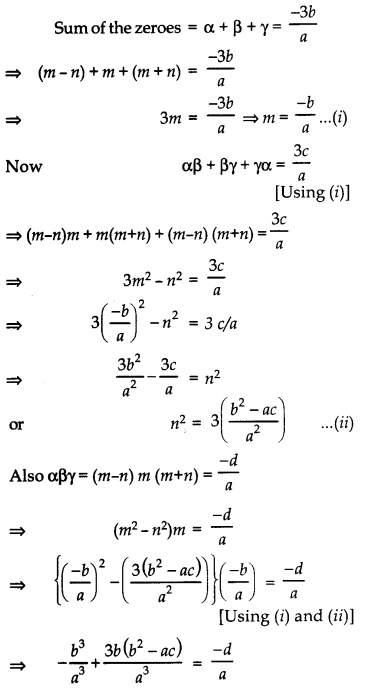
Multiplying throughout by a3, we get – b3 + 3b (b2 – ac) = – a2d
⇒ – b3 + 3b3 – 3abc + a2d = 0
or 2b3 – 3abc + a2d = 0
Note: Three numbers are said to be in Arithmetic Progression (A.P.). If each number is obtained by adding a constant to the previous number e.g. 3, 7, 11 are in A.P. Generally we take three numbers in A.P. as a – d, a, a + d.
It would be discussed in detail in Second term.
Question 3.
Find a relation between p and q, if one zero of x2 + px + q is 37 times the other.
Answer:
Let α, β be the zeroes of the polynomial
x2 + px + q
then α + β = – p, αβ = q
α = 37β (given)
∴ α + β = – p
⇒ 38β = – p
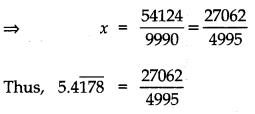
Multiple Choice Questions
Choose the correct option out of four given in each of the following:
Question 1.
The graph of p(x) is shown alongside. The number of zeroes of p(x) are:
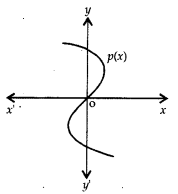
(a) 1
(b) 2
(c) 3
(d) 4
Answer:
(a) 1
Question 2.
If one zero of polynomial (k2 + 16) x2 + 13x + 8k is reciprocal of the other then k is equal to
(a) – 4
(b) +4
(c) 8
(d) 2
Answer:
(b) +4
Question 3.
If α and β are zeroes of the polynomial p(x) = x2 + mx + n, then a polynomial whose zeroes are \(\frac{1}{\alpha}, \frac{1}{\beta}\) is given by
(a) nx2 + mx + 1
(b) mx2 + x + n
(c) x2 + nx + m
(d) x2 – mx + n
Answer:
(a) nx2 + mx + 1
Question 4.
If the graph of y = p(x) does not cut the x-axis at any point, then polynomial has
(a) one zero
(b) two zeroes
(c) no zeroes
(d) infinite no. of zeroes
Answer:
(c) no zeroes
Question 5.
Sum of the zeroes of the polynomial p(x) = – 3x2 + k is
(a) \(\frac{k}{3}\)
(b) \(\frac{-k}{3}\)
(c) 0
(d) k
Answer:
(c) 0
Question 6.
If x – 1 is a factor of p(x) = kx2 – √2x + 1, then the value of k is
(a) √2 – 1
(b) – √2 + 1
(c) – 1 – √2
(d) 1 + √2
Answer:
(a) √2 – 1
Question 7.
Number of zeroes of a polynomial of degree n is
(a) equal to n
(b) less than n
(c) greater than n
(d) less than or equal to n
Answer:
(d) less than or equal to n
Question 8.
Zeroes of the polynomial p(x) = 2x2 – 9 – 3x are
(a) 3, \(\frac{3}{2}\)
(b) –\(\frac{3}{2}\) , 3
(c) 2, 3
(d) 9, \(\frac{3}{2}\)
Answer:
(b) –\(\frac{3}{2}\) , 3
Question 9.
If (α – β), α, (α + β) are zeroes of the polynomial p(x) = 2x3 – 16x2 + 15x – 2, value of α is
(a) 8
(b) 0
(c) \(\frac{3}{8}\)
(d) \(\frac{8}{3}\)
Answer:
(d) \(\frac{8}{3}\)
Question 10.
If n represents number of real zeroes for the polynomial ax3 + bx2 + cx + d then which of the following inequality is valid
(a) 0 < n < 3
(b) 0 < n < 3
(c) 0 < n < 3
(d) 0 < n < 3
Answer:
(c) 0 < n < 3
Question 11.
Number of quadratic polynomials having – 2 and – 5 as their two zeroes is :
(a) one
(b) two
(c) three
(d) infinite
Answer:
(d) infinite
Question 12.
If α, β, γ are zeroes of the polynomial p (x) such that α + β + γ = 2, αβ + βγ + γα = 5, αβγ = – 7, then p(x) is:
(a) x3 – 2x2 + 5x – 7
(b) x3 + 2x2 – 5x + 7
(c) x3 – 2x2 – 5x – 7
(d) x3 – 2x2 + 5x + 7
Answer:
(d) x3 – 2x2 + 5x + 7
Question 13.
If the sum of products of zeroes taken two at a time of polynomial p(x) = x3 – 5×2 + cx + 8 is 2 then the value of c is
(a) 2
(b) – 2
(c) 8
(d) – 5
Answer:
(a) 2
Question 14.
The division algorithm states that given any polynomial p(x) and any non-zero polynomial g(x) there are polynomial q(x) and r(x) such that p(x) = g(x) q{x) + r(x), where r(x) is
(a) either = 0 or deg. r(x) < deg. g(x) (b) either = 0 or deg. r(x) > deg. g(x)
(c) a linear polynomial or deg. r(x) = deg. g(x)
(d) either = 0 or deg. r(x) < deg. g(x)
Answer:
(d) either = 0 or deg. r(x) < deg. g(x)
Question 15.
If divisor, quotient and remainder are x +
(a) 3x2 + x + 1
(b) 3x2 – x – 1
(c) 3x2 + x – 1
(d) 3x2 – x + 1
Answer:
(c) 3x2 + x – 1
Fill in the blanks
Question 1.
The zeroes of the polynomial x2 – 49 are ______________ .
Answer:
± 7
Question 2.
The quadratic polynomial, whose sum and product of zeroes are 4 and – 5 respectively is _____________ .
Answer:
k(x2 – 4x – 5)
Question 3.
The value of the polynomial p(x) = 4x2 – 7 at x = – 2 is _______________ .
Answer:
9
Question 4.
Product of zeroes of a polynomial p(x) = 6x2 – 7x – 3 is _______________ .
Answer:
– \(\frac{1}{2}\)
Question 5.
If one zero of 3x2 – 8x +2k + 1 is seven times the other, then k is _________________.
Answer:
\(\frac{2}{3}\)
Question 6.
The degree of the constant polynomial is _______________ .
Answer:
zero
Question 7.
A real number k is a zero of the polynomial p(x) if and only if _______________.
Answer:
p(k) = 0
Question 8.
The shape of the graph of a cubic polynomial is _______________ .
Answer:
not fixed
Question 9.
If α, β and γ are the zeroes of the cubic polynomial px3 + qx2 + rx + s; a ≠ 0, then α + β + γ = ____________ , αβ + βγ + γα = _____________ and αβγ = ___________.
Answer:
\(\frac{-q}{p}, \frac{r}{p}, \frac{-s}{p}\)
Question 10.
The standard form of the polynomial x3 – x6 + x5 + 2x2 – x4 – 5 is ______________ .
Answer:
x6 + x5 – x4 + x3 + 2x2 – 5 or – 5 + 2x2 + x3 – x4 + x5 – x6

You can also download Maths NCERT Solutions Class 10 to help you to revise complete syllabus and score more marks in your examinations.
